|

by Ancient Code
March 08, 2018
from
Ancient-Code Website
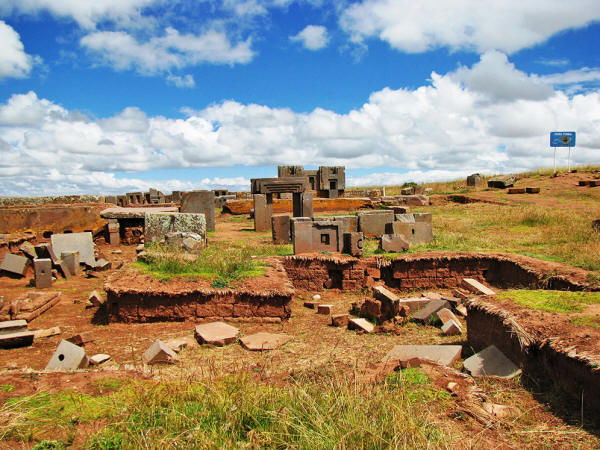
One of the most mysterious ancient sites composed of supermassive
megaliths and stones that appear to be worked with laser-like tools
was built thousands of years ago in modern-day Bolivia.
Located not far from another amazing site -
Tiahuanaco - the ruins of Puma
Punku have puzzled experts for decades.
Some 45 miles west of the city of La Paz in Bolivia, we find an
ancient site that is unlike any other on Earth.
Shattering traditional views on ancient cultures, the archaeological
site of
Puma Punku features incredibly
precise stones, precision cuts, and polished surfaces on stones that
have defied explanation for centuries.
Some of the stones at Puma Punku were so finely polished that they
appear smooth as glass.
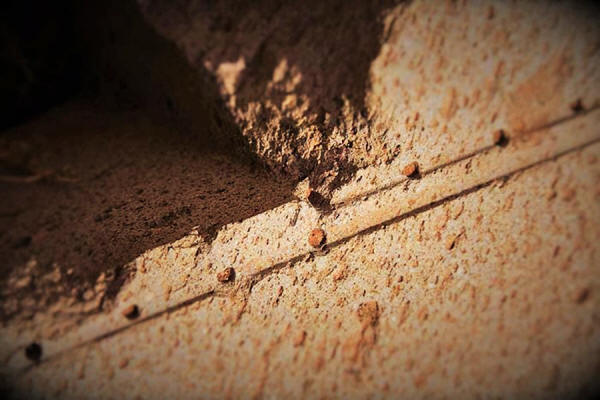
Only a few places on earth display this type of stonework.
It's as if thousands of years ago, an unknown culture used advanced
tools to shape and form massive andesite stones. Some of these rocks
have been cut with such precision that they fit together perfectly
and are interlocked with each other without the use of mortar.
Even more fascinating is the fact that not a single sheet of paper
can fit between some of these stones.
In this article, we take a look at Puma Punk and its history,
bringing you 50 incredible facts about one of the most mysterious
archaeological sites on the surface of the planet.
The ancient ruins of Puma Punku are located in modern-day Bolivia.
Puma Punku is located near Tiahuanaco, in fact, it's less than a
quarter-mile northeast of Puma Punku. Puma Punku and Tiahuanaco may
have been in fact one massive complex.
Tiahuanaco's most distinctive feature, other than the wall of faces,
is
the Gate of The Sun. It is believed
that, because of certain markings on stones found at Puma Punku, the
Gate of the Sun was originally part of Puma Punku.
Puma Punku has a length of 116.7 meters and a width of 167.36
meters.
The archaeological site of Puma Punku consists of an unwalled
western court, a central unwalled esplanade, a terraced platform
mound that is faced with stone, and a walled eastern court.
Tiahuanaco may have been an ancient metropolis according to experts,
as more than 40,000 inhabitants called it home.
Tiahuanaco features a massive wall which, according to some authors,
displays all the races of mankind, even elongated skulls, people
wearing turbans, people with broad noses, people with thin noses,
people with thick lips, people with thin lips.
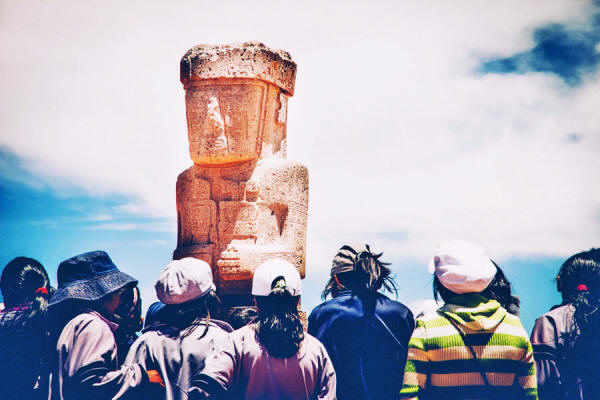
At its peak, the Tiwanaku culture dominated the entire Lake Titicaca
basin as well as portions of Bolivia and Chile.
In the vicinity of Tiahuanaco, experts excavated a mysterious object
called the
Fuente Magna Bowl. The Ceramic bowl
has Sumerian cuneiform and Proto-Sumerian hieroglyphic written on
it.
Since Puma Punku is of great interest to scholars, the area within
the kilometer separating the Puma Punku and Kalasasaya complexes
have been surveyed using ground-penetrating radar, magnetometry,
induced electrical conductivity, and magnetic susceptibility.
In Aymara - an Aymaran language spoken by the Aymara people of the
Andes - Puma Punku's name means "The Door of the Puma."
The archaeological site is a treasure of ancient history located
deep within the Andean mountain. Puma Punku is located at an
altitude of nearly 13,000 feet.
Given the fact that Puma Punku lies at an altitude of almost 13,000
feet, it means that the ancient site is above the natural tree line,
which in turn means NO trees grew in that area.
The fact that no trees grew in the area challenges the idea that the
ancient builders used wooden rollers to transport massive stones
from where they were quarried.
Mainstream scholars argue that the massive stones used in the
construction of Puma Punku were transported thanks to a large labor
force. Another theory suggests that the ancient builders of Puma
Punku made use of the llama skin ropes and the use of ramps
and inclined planes.
Researchers have found no evidence whatsoever that the ancient
builders of Puma Punku knew about the wheel.
Despite the fact that Puma Punku is believed to have been built
around 500 AD, many researchers claim that this ancient site, just
as Tiahuanaco, could predate the Inca themselves.
The Ancient Inca denied having anything to do with the building of
Tiahuanaco or Puma Punku. This means that the culture that built
these sites existed INDEPENDENTLY of the Inca, predating them as
well.
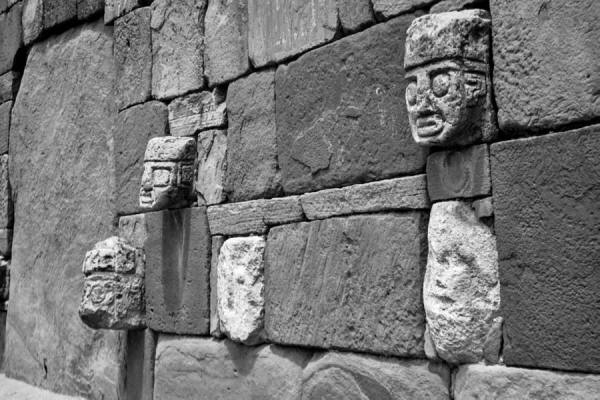
Puma Punku is not
isolated.
It is part of a massive
complex of temples, plazas and even pyramids, and is believed to
have belonged to the ancient Tiahuanaco culture, which predates the
ancient Inca by millennia.
Puma Punku features massive stones. But the fact that there are so
many of them make makes Puma Punku's stones amongst the largest
found on the planet.
Puma Punku consists of a mixture of andesite and red sandstone.
Despite having been researched, analyzed, and studied by experts
around the globe, not a single researcher has managed to explain how
the ancient builders of Puma Punku managed to cut, polish and
transport the stones at the site.
Modern day engineers
argue that the base of the Puma Punku temple was constructed
using a technique called layering and depositing.
Oral legends indicate that the first inhabitants of Puma Punku
were unlike ordinary humans.
These 'early people' had the ability to 'carry' megalithic
stones through the air with the use of SOUND.
The eastern edge of the Puma Punku is occupied by what is called
the Plataforma Lítica.
The so-called Plataforma Lítica consists of a stone terrace that
is 6.75 by 38.72 meters (22.1 by 127.0 feet) in dimension.
This terrace is paved with multiple enormous stone blocks.
One of the largest stones at Puma Punku is 7.81 meters long,
5.17 meters wide, averages 1.07 meters thick.
The estimated weight of this massive rock is 131 metric tons.
But this isn't the only
one.
Another massive rock at
Puma Punku is 7.90 meters long, 2.50 meters wide, and averages 1.86
meters thick. Its weight has been estimated to be 85.21 metric tons.
Both of these stone blocks are part of the Plataforma Lítica
and composed of red sandstone
Puma Punku's H Blocks are the best-known feature of the site.
The H blocks at Puma Punku have approximately 80 faces each.
Some authors suggest that given the precision cuts and incredible
angles seen on Puma Punku's blocks, it is possible that the ancient
builders made use of prefabrication and mass production,
technologies far in advance of the Tiwanaku's Inca successors
hundreds of years later.
Experts note that the precision with which these angles have been
used to create flush joints is indicative of a highly sophisticated
knowledge of stone-cutting and a thorough understanding of
descriptive geometry.
As noted by researchers, many of the joints are so precise that not
even a razor blade will fit between the stones. Much of the masonry
is characterized by accurately cut rectilinear blocks of such
uniformity that they could be interchanged for one another while
maintaining a level surface and even joints.
One of the closest stone quarries used by the builders of Puma Punku
was located some 10 km away, near Lake Titicaca.
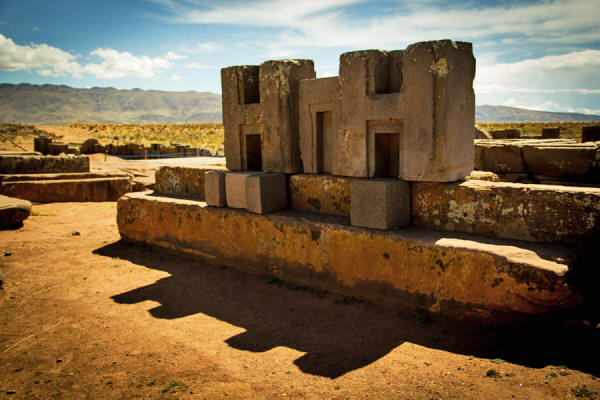
The furthest identified
quarry is believed to have been located near Copacabana Peninsula
about 90 km away from and across Lake Titicaca.
According to archeological investigations,
Puma Punku's 'H blocks' match each
other with such an extreme precision that the architects most likely
used a system of preferred measurements and proportions.
While it is amazing what the ancients achieved thousands of years
ago in terms of transportation, design, and logistics, the ancient
engineers that built Puma Punku and Tiahuanaco were also adept at
developing a civic infrastructure at this complex, constructing
functional irrigation systems, hydraulic mechanisms, and waterproof
sewage lines.
Despite the fact we see ruins today, Puma Punku is thought to have
been "unimaginably wondrous," adorned with polished metal plaques,
brightly colored ceramic and fabric ornamentation, and visited by
costumed citizens, elaborately dressed priests, and elites decked in
exotic jewelry.
There are some still unfinished stones found near Puma Punku.
Experts say that the unfinished stones show some of the techniques
that were used to shape the blocks.
Experts say that Puma Punku's blocks of stone were initially pounded
by stone hammers, which can still be found in numbers on local
andesite quarries, creating depressions, and then slowly ground and
polished with flat stones and sand.
Excavations have documented,
"three major building
epochs, in addition to small repairs and remodeling".
Does Puma Punku feature...
The
Ultimate Ancient Astronaut Evidence?
by Ivan
Petricevic
February 26,
2018
from
Ancient-Code Website
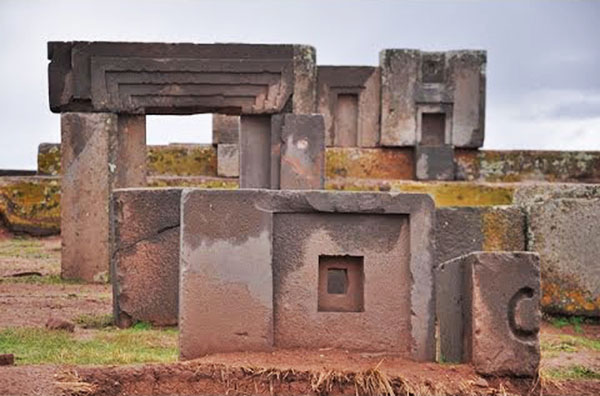
Located just 45 miles west of La Paz high in the breathtaking Andes
mountains lie the mysterious ruins of an archaeological site called
Puma Punku.
This ancient site is home to megalithic stones which many
researchers say are among the largest on the planet. Some of the
megaliths here measure up to 26 feet long and weigh more than 100
tons each.
This incredible site was built thousands of years ago by an
extremely advanced culture. Today, Puma Punku is considered a large
temple complex or monument group that is part of
the Tiwanaku Site near Tiwanaku,
Bolivia.
Tiwanaku is significant in Incan traditions because it is believed
to be the site where the world was created. Puma Punku signifies
"The Door of the Puma."
As noted by the Andean specialist, Binghamton University
Anthropology professor W. H. Isbell, a radiocarbon date was
obtained by Vranich from organic material from lowermost and oldest
layer of mound-fill forming the Puma Punku.
This layer was deposited
during the first of three construction epochs and dates the initial
construction of the Puma Punku at 1510 ±25 B.P.
Puma Punku is so unique in the way that it was constructed and
shaped and positioned, that it is the most intriguing ancient site
on the planet. Mainstream scholars believe the blocks found at Puma
Punku were formed by 'hand' with 'primitive' stone tools.
But some researchers
point to the intricate stonework as evidence of the use of advanced
precision technology.
-
How exactly could
such primitive people, living thousands of years ago, have
produced such flawless stonework?
-
Is it possible
that the ancient builders of Puma Punku have fabricated the
megalithic stones with advanced technology?
-
Precision tools
that could have facilitated them to accomplish these marvels
of engineering and construction, clean cuts, precise angles,
would that be really possible without the aid of "modern"
technology?
Many people today find
that quite unlikely.
If you look at the stones carefully, you can see some intricate
stonework, as though they used machine tools or even lasers. It's
incredible.
At Puma Punku you will find these incredible stones with perfect
right angles, and some stones have small drill holes which have been
evenly spaced along this groove which makes you wonder whether or
not it is possible that the ancient builders of Puma Punku used
some sort of advanced machinery.
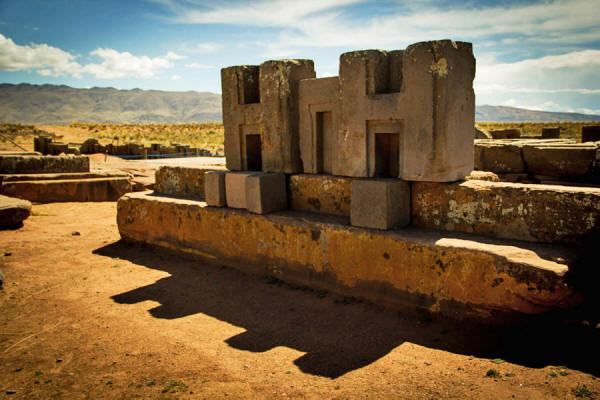
Monolito
by Diegoom Urbina
A
transportational and logistical nightmare
After years of research, archaeologists have said the massive stones
were hewn at quarries over 60 miles away and then
rolled to Puma Punku on logs.
However, what we seem to forget here and what nobody talks about is
the fact that the archaeological site of Puma Punku is located at an
altitude of 12,800 feet (about 4,000 meters a.s.l.)
This means that it is
located above the natural tree line so this means that NO trees grew
in that area which means that no trees were cut down in order to use
wooden rollers.
This brings us to the obvious question as to how did the ancient
builders of Puma Punku transport huge blocks of stone to their
destination?
Sure, they could have
brought logs from elsewhere, but that would have been a
transportational nightmare at that time, and even a huge labor force
would not have been enough for these massive stones to arrive at
their destination.
We simply have too many questions about the technology used,
transportation, logistics, etc…, and it is hard to believe that all
of this was achieved without the use of power tools
and advanced forms of transportation.
Moving these massive blocks of granite from their quarries and
bringing them to Puma Punku would have required
some type of advanced technology,
means by which ancient cultures could have lifted these massive
stones and placed them in their positions.
Puma Punku is simply put, one of those places where, when you look
at those incredible constructions, manipulated with that much
perfection, your imagination just fires up, there are so many
possibilities at this point, and conventional archaeological
explanations just do not suffice.
The right questions need to be asked, and there are so many
mysteries that surround Puma Punku… from the materials used to aid
them in the constructions… to the constructions methods and
transportation of the blocks and the answer probably lies in front
of us.
Tiahuanaco,
equally stunning and mystifying
In 1549, while searching for the capital of the Inca Empire, Spanish
conquistadors led by Pedro Cieza de León crossed into Bolivia
and found the ruins of an archaeological site called Tiahuanaco.
Less than a quarter mile
northeast of Puma Punku, modern-day researchers believe Tiahuanaco
was once the center of civilization with more than 50,000
inhabitants.
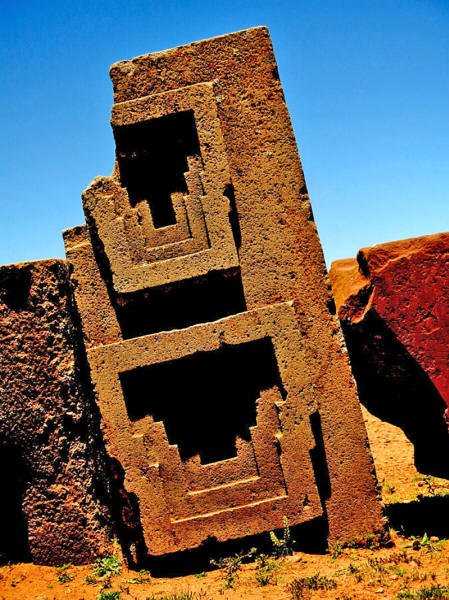
Piedra de Puma Punku
by Adrià Torres Capsada
In fact, Tiahuanaco is probably the greatest American culture that
many people haven't heard of. It was one of the most important
antecedents of the Inca and their history.
The level of achievement
in architecture, in political development, agriculture, industries
was unlike anything found elsewhere in South America, and most
scholars agree that Tiahuanaco was mysteriously abandoned around
1100 AD, for reasons we still do not know.
However, numerous excavations revealed a great amount of information
about Tiahuanaco.
In the 1960s, the Bolivian government excavated
and unearthed the Subterranean Temple at Tiahuanaco.
Within the walls of the square sunken courtyard, researchers
discovered hundreds of mysterious stone heads with a diverse range
of features.
Most scholars and authors agree that there are all the races of
mankind represented at this wall, even elongated skulls, people
wearing turbans, people with broad noses, people with thin noses,
people with thick lips, people with thin lips, and some of the
statues are particularly unusual because they do not seem to
represent the local people...
These mysterious places seem to represent every type and shape of
human head existing on the planet.
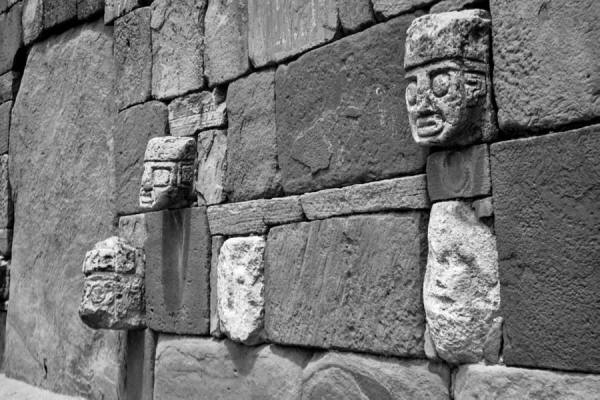
Tiahuanaco
by Mauricio Araya
Two of them, which are very intriguing, were created in white in
color, and they look very much like
grey alien heads, say Ufologists.
Viracocha, the
Andean Creator God
A giant statue at the center of the sunken temple depicts the
creator god,
known as Viracocha.
Curiously, Viracocha was
depicted having many characteristics which are unlike those of the
native population.
This raises an
interesting question:
Why would the
inhabitants of Tiahuanaco depict their most prominent god with
features unlike their own?
For example, Viracocha
was depicted having a beard and a mustache, something that is a very
unusual thing because American Indians do not have beards and
mustaches.
So,
who
was Viracocha, and is it possible that there is more to
him than what we have been led to believe?
Sumerian
writing in America?
One of the most fascinating archaeological artifacts ever discovered
near Tiahuanaco is the famous
Fuente Magna Bowl.
The artifact is a ceramic bowl, and it has written on its surface
Sumerian cuneiform and Proto-Sumerian hieroglyphic
script. This is a huge problem for mainstream scholars as these two
civilizations were never connected and are located on the opposite
side of the world.
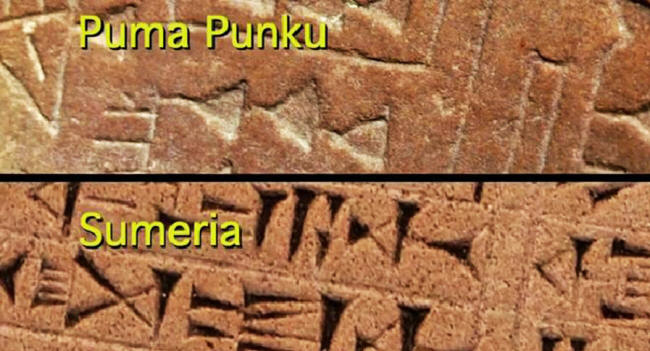
In fact, these two ancient cultures were separated by more than
8.000 miles, and yet the Fuente Magna Bowl draws a direct
connection between the
ancient Sumerians and Tiahuanaco,
and Puma Punku.
|










